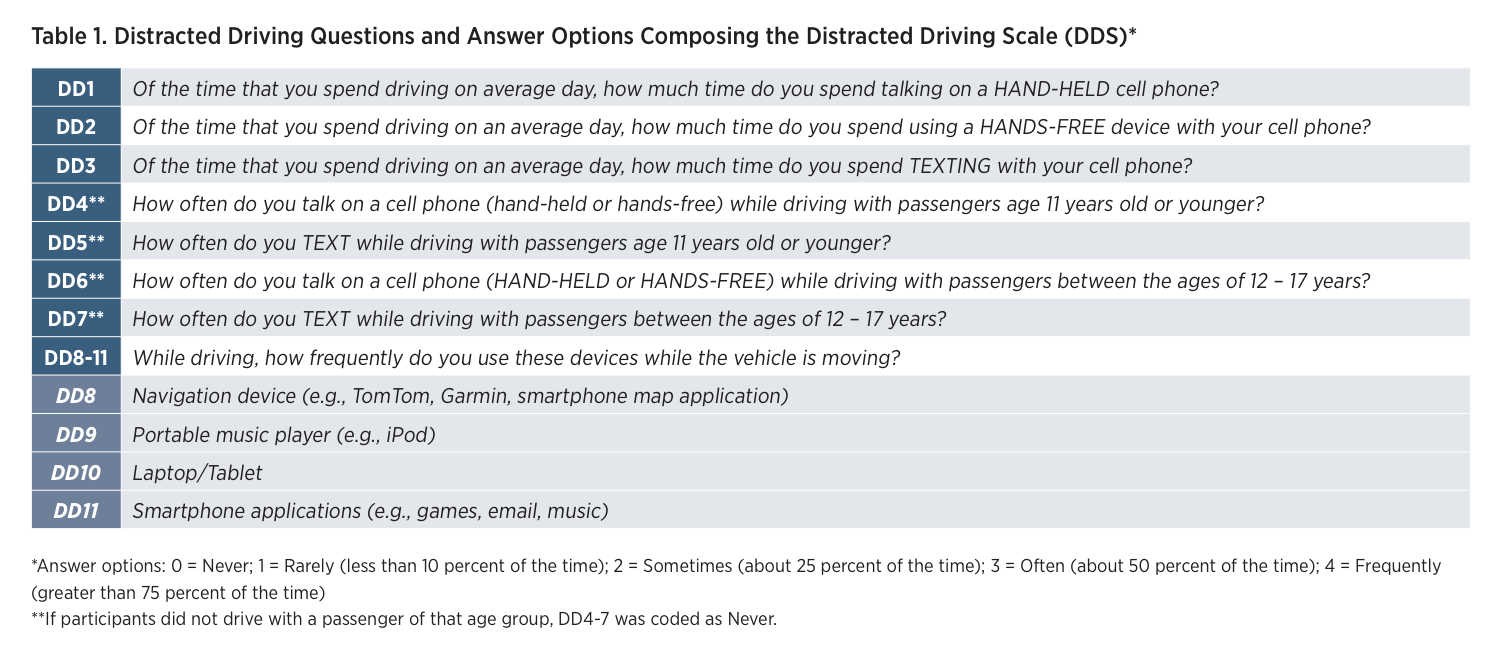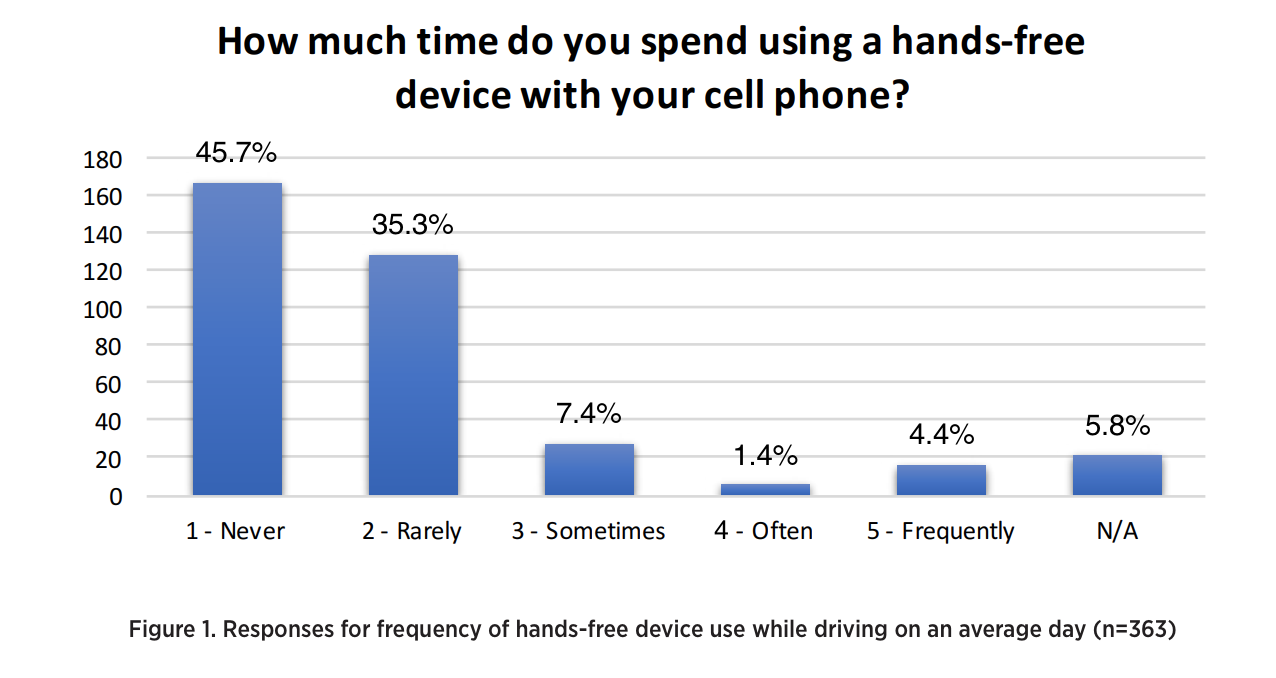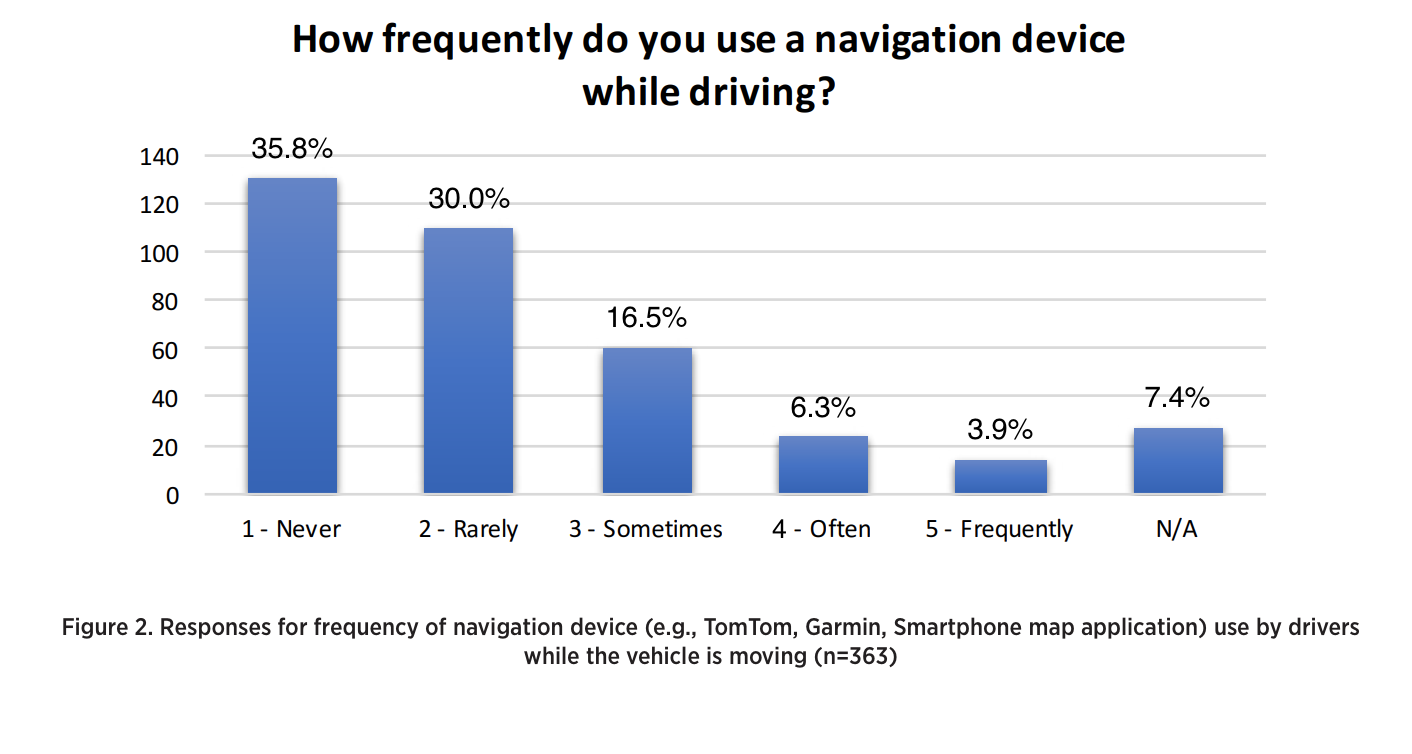
Distracted Driving Behaviors and Beliefs among Older Adults: A LongROAD Analysis of the Training, Research, and Education for Driving Safety Study
This research explores the behaviors and attitudes of elderly drivers regarding cell phone use while driving as well as the prevalence of specific modes of cell phone use including talking, texting, emailing, browsing the internet, and navigating.
September 2017
Suggested Citation
For media inquiries, contact:
Tamra Johnson
202-942-2079
TRJohnson@national.aaa.com
Abstract
Distracted driving is an established cause of motor vehicle crashes for all ages. With the rapidly growing elderly population and more adults embracing technology, distracted driving is also increasing in prevalence within that population—particularly cell phone usage behind the wheel. This research explores the behaviors and attitudes of senior drivers regarding cellphone use while driving as well as the prevalence of the mode of cell phone use behind the car such as, talking, texting, emailing, browsing the internet and navigating. It also explores possible characteristics that would predict the frequency of distracted driving.
Distracted driving is an established cause of motor vehicle crashes, for all ages. Nearly 60% of crashes involving younger drivers are linked to distraction (AAAFTS, 2015). This research brief provides evidence from a recent survey that as more older adults embrace technology, distracted driving—in particular, using cell phones behind the wheel—is prevalent among them as well. According to a recent survey conducted by AAA Foundation for Traffic Safety and the University of California San Diego, the majority of drivers aged 65 and older—nearly 60%—have used their cell phone in some capacity (i.e., texting, making calls, and answering calls) while driving. More than a quarter of these older drivers have engaged in distracting behaviors while driving with a minor in the car. Among those, 32% have talked on the phone—either with hands-free or hand-held devices—with younger children (under age 11) in the car, while 42% have done so when accompanied by older children (12- to 17 year-olds). While distracted driving encompasses a wide range of risky behaviors including but not limited to eating, talking with passengers, reaching for belongings, etc., this survey focused solely on cell phone use while operating a vehicle. The findings suggest the need for interventions to reduce distracted driving behaviors among older adults, especially given the rapidly growing older adult population, with their age-associated physiologic changes, such as slower reflexes, reduced contrast sensitivity, and other driving-impairing conditions.
Methods
Eligible respondents were required to be 65 years of age or older, use a cell phone at least once a week, drive at least once a week, be a U.S. resident, and speak English. Respondents were recruited through flyers in participating physicians’ offices; social media; posts on the Training, Research, and Education for Driving Safety (TREDS) website (treds.ucsd.edu); regional newspaper advertisements; and various online and email Listservs. Surveys were completed either online or in person. In-person participants were given a paper copy of the survey and an addressed stamped envelope to return the survey to research staff. Paper surveys were only available in San Diego.
A Distracted Driving (DD) survey was previously developed and validated in college (Hill et al., 2015) and middle-aged (Engelberg et al., 2015) populations. For this research, the 64-question-survey (maximum, with skip questions) was modified to target older adults based on expert feedback considering the driving patterns of older adults. The survey focused on five categories of questions: 1) demographics, including personal health issues, 2) personal cell phone behaviors and observed behaviors of others, 3) effectiveness of potential interventions, 4) participants’ perceived driving ability and ability to multitask, and 5) cell phone behavior when driving with minors. The study was initially piloted with 20 San Diego older adults using a mix of random sampling and convenience sampling. The pilot feedback was used to assess face validity and modify the survey accordingly.
From the final survey, a distracted driving scale (DDS) was created by summing responses on DD questions in terms of frequency of behavior—for example, “How often do you text while stopped at red lights?” with five Likertscale response options (0=never, 1=rarely, 2=sometimes, 3=often, 4=frequently). See Table 1 for all survey items. The DDS was based on items used in the middle-aged adult-based DDS (Engelberg et al., 2015).
Results
Participant Characteristics
A total of 397 respondents accessed the survey, 363 of which (91.4%) met the eligibility criteria. Respondents were mostly female (56.6%), white (87.9%), not employed (74.4%), married (59.6%) and smartphone owners (82.8%) and were an average age of 73 years (SD = 6.6). The majority of respondents had a household income of over $49,999 (76.4%) and lived in a single-family home (78.5%).
Behavior and Attitudes
Participants were generally active drivers, driving an average of nearly six days per week, making an average of almost three round trips per day. The majority of respondents owned smartphones (82%) and used them for functions such as talking (99.7%), texting (78.7%), emailing (64.4%), browsing the internet (56.9%), and navigating (54.9%). Nearly 60% of respondents reported using their cell phones while driving. Respondents reported using their phone to talk or text while driving, at rates of 42% and 9%, respectively. Navigation was another common use. When asked specifically about their answering of incoming calls and placing of calls, the rates were higher, as listed below.
Fifty seven percent of respondents reported answering incoming calls. Of those people who reported answering calls, 40.4% said they take the call and converse while driving, 21% pull over and take the call, 17.5% tell the caller they will call back, while 21% will answer the call only from a recognized number. Of the respondents who were employed, 30% felt obligated to take work-related calls while driving.
Almost 40% of respondents reported placing outgoing calls while driving. Among those who reported placing outgoing calls, around 45% used voice dialing, while 25.75% used speed dialing, 19% scrolled through saved numbers and around 10% manually entered numbers.
More than a quarter of the older drivers reported engaging in distracting behaviors with a minor in the car. Thirty-two percent talk on the cell phone while driving minors under age 11, in addition 3% text while driving minors younger than 11. Approximately 43% talk on the phone while 9% of respondents text, while driving children ages 12 to 17.
Nearly 80% of respondents rated themselves as safer drivers compared with their peers, and 38% rated themselves as having fair to excellent ability to perform other tasks while driving. Respondents also rated themselves as capable to very capable of driving safely while using a hand-held phone (40%), using a hands-free phone (78%), texting (9%), or doing other tasks while driving (38%).
Citations and Crashes
Eighteen percent of respondents reported having been involved in collisions in the past two years. Forty-three percent reported having received a non-parking violation in the past two years. While only 3% (10 respondents) received a citation for talking on the phone while driving, all of them reported having curtailed this behavior after the citation. The majority of respondents (96%) felt that they were at least somewhat familiar with their state laws regarding cell phone use while driving. Fifty-six percent reported that cell phone laws changed their distracted driving behaviors.
More than half of the respondents stated that if insurance companies did not cover crashes that involved distracted driving behaviors, they would be more likely to change their behaviors. Forty-three percent stated that if a distracted driving citation resulted in points on their drivers’ licenses, they would also curtail their distracted driving behaviors.
Predictors of Distracted Driving Behaviors
Respondents who reported engaging in any type of distracted driving behavior to any extent were likely to answer that they had engaged in more than one type. This indicates that there were high correlations between engagement frequencies and types of distracted driving behaviors. Two of the most common types of distracted driving behaviors that respondents reported engaging in while driving were using a hands-free device on a cell phone, as well as using a navigation device (see DD2 and DD8 in Table 1, respectively). Figures 1 and 2 show the response distributions on these behaviors.
A linear regression model predicting frequency of distracted driving as measured by DDS was developed. Being younger in age, driving more days per week, being employed or self-employed, owning a smartphone, and reporting higher self-ratings of driving skill while talking hands-free were associated with greater frequency of distracted driving behaviors. In addition, those who were employed scored 0.75 points higher on the DDS as compared to those who were unemployed.
Discussion
Using a modified distracted driving survey previously validated in the college student (Hill et al., 2015) and middleaged populations (Engelberg et al., 2015), the current study demonstrates that the majority of older adults drive while distracted by the use of mobile devices. More than 80% of the respondents reported owning a smartphone and using the device for texting, talking, and/or browsing the internet. Almost 60% of the respondents reported using their cell phone in some capacity while driving including taking calls (58%), making calls (39%), and texting (9%). Being younger in age, driving more days per week, owning a smartphone, rating oneself as capable when driving, and using a handsfree phone were associated with greater frequency of distracted-driving behavior.
Distracted driving puts the driver and passengers at risk. More than a quarter reported driving with a minor (usually a grandchild) in their car. Of those, 32% reported driving and talking with either a hands-free or hand-held device while with children aged 11 years or younger. Forty-two percent reported engaging in the same behaviors with children aged 12-17. Texting and driving with minors in the car was reported by 3% of drivers with minors aged 11 and under in the vehicle, and 9% of the drivers with minors aged 12-17.
Another concerning finding is that among the employed sample, 30% reported taking work-related calls while driving. Self-employment was associated with greater frequency of distracted driving. These findings suggest that interventions to reduce distracted driving behavior should target not only employers, but also those who are self-employed.
The survey explored several distracted driving interventions to gauge respondents’ perceptions of effectiveness and receptivity. More than half of respondents reported changing their behavior due to state cell phone laws. Such responses lend support for state laws targeting distracted driving behaviors. Participants who reported receiving a ticket for phone use while driving unanimously reported that experience changed their behavior. The majority of participants also reported that a hypothetical insurance policy change or points on their license would change their behavior.
In addition to punitive measures, other interventions may target behavior change and identification of distracted drivers. One example of the former is the Just Drive program through the University of California, San Diego TREDS group, encouraging participants to be safe and responsible drivers. The class currently targets employees but can be modified to target older drivers including those who are self-employed. Other potential mitigation strategies may include healthcare providers who can screen for medical comorbidities and administer a modified DDS to identify distracted drivers who can benefit from intervention.
The study is not without limitations. The majority of respondents were white non-Hispanic females in a higher income bracket than the average income in the state of California. Most respondents completed the survey online, perhaps skewing results to those who are technologically savvy and have access to computers and smartphones. The survey is self-reported, which, due to social desirability bias, may cause underreporting by those who are reluctant to admit to distracted driving behavior. However, the anonymity of the survey may help mitigate this bias. Future studies should take into account real-time recording to code and analyze actual distracted driving.
In conclusion, cell phone use while driving is a prevalent problem among not only college-aged and middle-aged people, but also older adult populations. Given that the number of older drivers will continue to grow and this population is engaging in distracted driving cell phone related behaviors, effective interventions to curtail these behaviors are crucial. Possible strategies include screening, education, citation, points on a license, and insurance policy changes, but more research is needed. In the meantime, the current results can shed light on directions of future program development and policy changes to help improve driving safety in the United States.
References
Carney, C., McGehee, D., Harland, K., Weiss, M., and Raby, M. (March 2015). Using Naturalistic Driving Data to Assess the Prevalence of Environmental Factors and Driver Behaviors in Teen Driver Crashes. AAA Foundation for Traffic Safety, Washington, DC.
Engelberg, J. K., Hill, L. L., Rybar, J., & Styler, T. (2015). Distracted driving behaviors related to cell phone use among middle-aged adults. Journal of Transport and Health, 2(3), 434-440. doi:10.1016/j.jth.2015.05.002
Hill, L. L., Rybar, J., Styer, T., Fram, E., Merchant, G., & Eastman, A. (2015). Prevalence of and attitudes about distracted driving in college students. Traffic Injury Prevention, 16(4), 362-367. doi:10.1080/15389588.2014.94 9340
Suggested Citation
For media inquiries, contact:
Tamra Johnson
202-942-2079
TRJohnson@national.aaa.com


